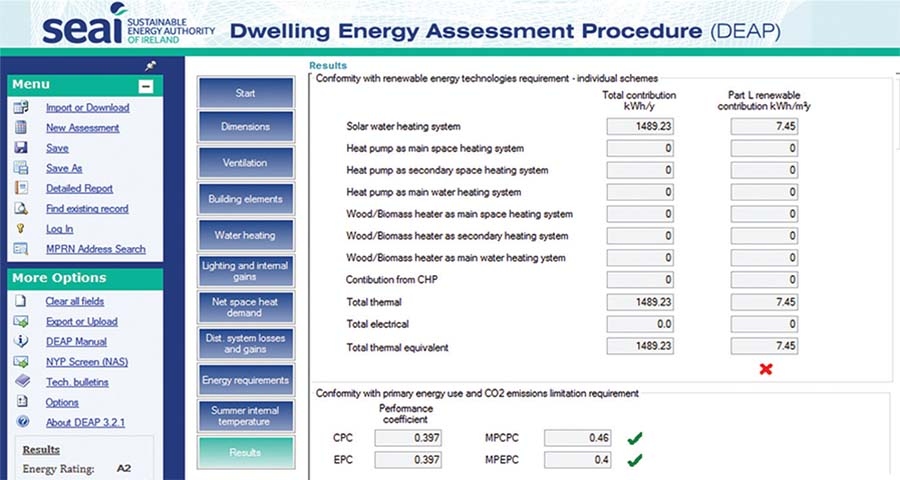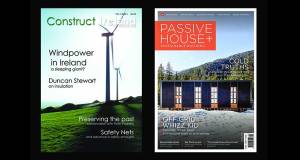
SEAI: Deap targets aren’t only way to meet Part L
Specifications for new homes which fall short of energy performance targets in the Dwelling Energy Assessment Procedure software may nonetheless comply with Part L of the Irish Building Regulations, the Sustainable Energy Authority of Ireland has said. This is potentially a significant development for passive house, a proven ultra low energy building strategy which is often undermined by the relatively crude assumptions in the Irish regulatory guidance and Deap software.
Responding to questions from Passive House Plus, SEAI’s CEO Dr Brian Motherway said: “SEAI does not claim that achieving a certain outcome in Deap is the only acceptable or appropriate way of demonstrating full compliance with Part L of the building regulations.”
Motherway’s comments – revealed in more detail below – add further weight to the case for passive house as an alternative method of compliance with Part L made by leading EU law & sustainable energy law expert Philip Lee in issue nine of Passive House Plus (Irish edition). As Lee explains, the legal obligation is to comply with Part L itself rather than the technical guidance documents, which don’t have the force of law. Part L consists of a few paragraphs, including a requirement to design new homes to reduce the primary energy demand and associated carbon emissions in so far as is “reasonably practicable” – using Deap to calculate both energy demand and carbon emissions – while generating a “reasonable proportion” of energy from renewable sources.
Writing in Passive House Plus, Philip Lee posited a passive house with a reasonably sized renewable energy system as an alternative method of meeting Part L, while noting that Part L itself needs to be updated to avoid breaching EU law by specifying a minimum level of renewable energy in the regulation itself – rather than in the non-binding guidance document – due to a requirement of article 13(4) the RES Directive which kicked in at the end of the year.
The targets in Deap – incorrectly viewed by many in the industry as mandatory for Part L compliance – include some but not all of the backstop targets set out in Technical Guidance Document L, namely the renewable energy generation targets of 10 kWh/m2/yr thermal energy or 4 kWh/m2/yr electrical, backstop U-values for all of the dwelling’s main elements and overall energy efficiency and carbon emissions targets, respectively called maximum permitted energy performance coefficients (MPEPCs) and maximum permitted carbon performance coefficients (MPCPCs). Other key TGD L targets such as airtightness test results, thermal bridging factors and boiler efficiency are omitted.
According to Brian Motherway: “Deap is the calculation methodology specified by Regulation L3(a) to calculate primary energy consumption and carbon dioxide emissions. As it is specified by the Regulation, and not the Technical Guidance Document, for the purpose of calculating primary energy and CO2 emissions, it is not subject to article 7(3). The EPC and CPC must be calculated in Deap. Other parameters specified in the TGD L can be demonstrated through alternative approaches if deemed appropriate by the designer / assigned certifier.”
Philip Lee has explained to Passive House Plus that while complying with L3(A) requires the use of Deap to calculate the dwelling’s EPC and CPC, this doesn’t mean in the case of a demonstrably low energy building such as a passive house that the dwelling must meet the maximum permitted EPC and CPC targets of 0.4 and 0.46 respectively in TGD L, on the basis that it can be demonstrated that the dwelling has reduced energy demand and carbon emissions in so far as is “reasonably practicable”.
Responding to questions from Passive House Plus that the wording in Deap may falsely lead the industry to view that hitting targets from TGD L is required to comply with Part L, Brian Motherway drew a dinstinction between conformance and compliance.
“The report in question is described as a "conformance" report and not a "compliance" report.” he said. “The conformance report can assist designers in achieving compliance without the necessity for multiple checks. However the issuing of a conformance report in Deap does not prevent a designer/ builder / owner / certifier from adopting alternative approaches to those described in the TGD L provided that the relevant requirements of the Regulations are complied with. The report specifically refers to TGD L at the top of the page you cite. Responsibility for compliance with Building Regulations rests with the owner, designer, assigned certifier and builder. The Local Authority is responsible for enforcement.
“The conformance report was originally developed for, and in consultation with, DECLG. We have discussed this matter with DECLG officials, who have confirmed their agreement with the points set out above. Notwithstanding this, if it is the case that there is any confusion in the market with reference to the language used in Deap, I am open to addressing this confusion either in the generality or specifically in the formal review of Deap which as you know is scheduled to take place in 2015, while again noting that SEAI does not determine what constitutes compliance with the regulations. SEAI is keen to ensure clarity around these issues for all stakeholders.”
Related items
-
 Key industry events at Energy Show 2024
Key industry events at Energy Show 2024 -
An Post takes top prize at Energy Awards
-
Government supported almost 27,200 home energy upgrades through SEAI in 2022
-
 Big picture - New Zealand rural passive home
Big picture - New Zealand rural passive home -
 Podcast: what we've learned from 20 years in green building mags
Podcast: what we've learned from 20 years in green building mags -
 45,000 more Irish homes face radon risk, new maps reveal
45,000 more Irish homes face radon risk, new maps reveal

